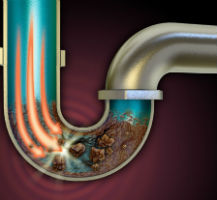
Have you ever taken a shower to soon discover that water levels are reaching your ankles, making with haste toward your calves? After a quick rinse, you make your escape, eyeing the area of murky water where your drain should be doing its job. The next step is to either whip out a drain snake or shrug your shoulders and hope gravity will do its job over time. If you aren’t one of the many having to cut their showers short for fear of flooding, perhaps you’re familiar with a kitchen sink you frequently have to take a plunger to. A blocked drain isn’t just an inconvenience. It can pose the risks of water damage to your home and even busted pipes.
Despite what the packaging promises, with some clogs, elbow grease and store-bought drain cleaners may not be enough to send that sitting water down where it belongs. In fact, in the case of a completely clogged drain, store-bought drain cleaners can cause permanent damage to your plumbing.
In kitchen and bathroom sinks, a plumbing-savvy homeowner can usually clear a drain themselves by removing the P-Trap, clearing it of debris and reattaching it. (Make sure to keep a bucket beneath the P-Trap when removing it to catch draining water.) Bathroom clogs are not as easily dealt with. For these, we recommend calling your local plumber for a fast, professional fix.
Depending on the severity of your clog, your plumber can use the cable/snake cleaning method or, in the case a stubborn clog, turn to hydro jetting. In the first method, your plumber will feed a piano wire drain snake down into your drain to scrape out and break up pipe blockages. In hydro jetting, high-pressure water is sent through the drain to remove tougher clogs.
Whatever you do, don’t ignore a partial clog! They will drain over time, but the more you put down those drains, the higher the chances are for a full clog to develop. If you are unsure of your clog situation, call your local San Antonio plumber for a professional opinion. For more plumbing tips and DIY, check out our informative video blogs!

